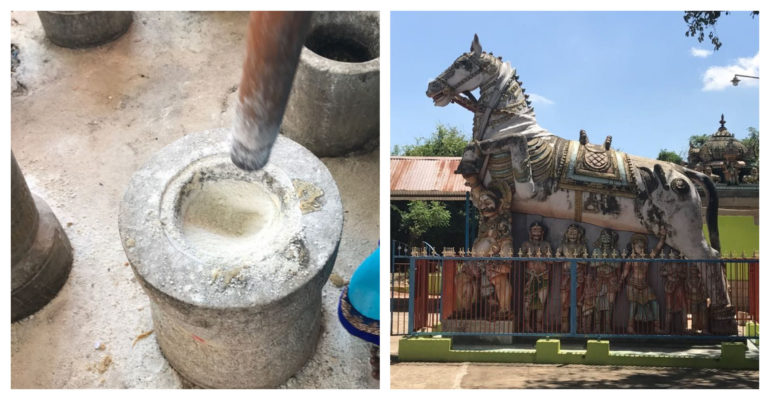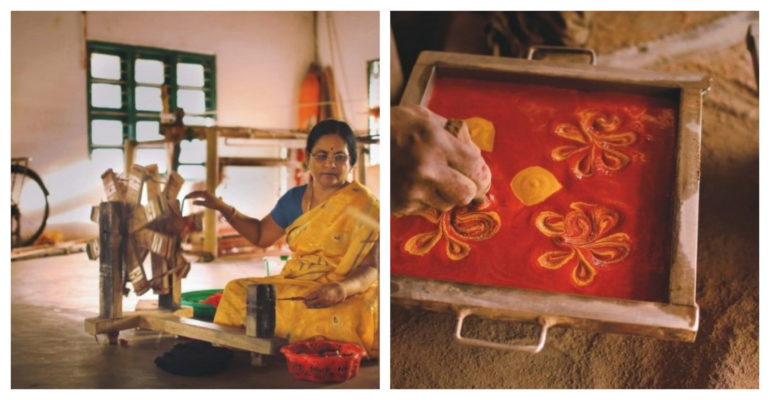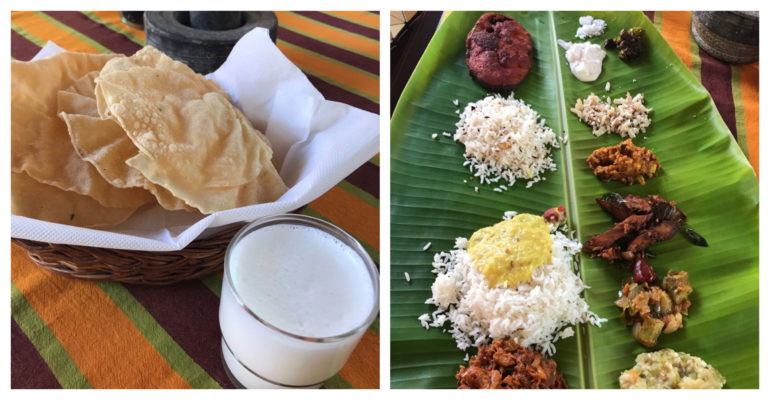There are several fascinating reasons to travel to the south of India. Steeped in history and rich culture, Tamil Nadu, in particular, offers a wide array of temples, homes, and traditions. The climate is of course, conducive to travel from October to March and I was lucky to get an opportunity right then.

As I understood the history of Chettinad, which is famous for its mansions, I learned that the Natukottai Chettiars are also known as the Nagarathars. The Chettiars were the original residents of Chettinad, who used the ancient methods of banking. The men usually travelled in large boats to Burma and other places to find their fortune in trade. They only returned to meet their families and to build and fill their mansions with beautiful Burma teak furniture, inlay work, Murano chandeliers, Belgian glass, etc. They were a very prosperous community.

Chettinad is in itself a cluster of 72 villages in the Sivaganga district of Southern Tamil Nadu. Visalam is a heritage boutique hotel managed by CGH Earth properties in Kanadugathan. Getting there by road was an enjoyable experience as the roads run parallel and clean all along the highway. Sighting the old mansion, one feels a sort of curiosity even though the façade is quite nondescript.

A storehouse of culture
The story behind the 70 year old heritage mansion speaks of the endearing love that a father had for his daughter who never got to live there as she passed away at a tender age. The father was KVAL Ramanathan Chettiar and his eldest daughter was Visalakshmi. She in turn passed it on to her daughter Valli.

What was built as a traditional mansion had to be restored into a building that could be divided into 15 liveable rooms, without actually touching the interiors. It still somewhat retains the same ambiance and spirit from the old times. CGH has indeed captured the essence of an old family home, keeping all the old structures intact. The sepia toned pictures of the family and the artifacts such as old urns, large salt jars, and narrow staircases preserve the mystery.

Intact with history
We were greeted warmly by the general manager, Febin Thomas and others in traditional Tamilian attire (Veshties) and offered the official welcome drink. After a chat, we were presented a rather large box containing what seemed like a fairly giant key. It felt like being offered the keys to the kingdom.

Sadly, it was only the key to our room but mystical no doubt. As we moved through the large halls, we actually experienced a palpable presence of the past ushering us into the guest rooms. We noticed that the rooms were very spacious with high ceilings, gleaming floors, beautiful windows, and doors characterising comfort and luxury.

The period furniture was made from Burma teak and the famous Aathangudy tiles were seen adorning the walls and the floors. An alluring kolam invited us into our abode. The pearly pristine walls raised a question in our minds as we enquired about their origin. And rightly enough, the story goes that it was the done thing in those times, as all the plastering of the walls and pillars were made from a formula of eggshells, lime, palm jaggery, and seashells ground together to make a base. Later, the walls were polished with egg white. It is a craft long gone.

Everything seemed local, like the towels, the bed runners, and even the uniforms of people seemed to be sourced from the age old hand weavers of Chettinad. Four-poster beds and carved doors gave a sense of the forgotten times. The outdoor garden boasted of an old haathgadi with hens and cocks freely roaming alongside scampering squirrels and fluttering dragonflies.

Visalam is a totally eco-conscious hotel that encourages rainwater harvesting and I noticed that even their drinking water is purified through reverse osmosis and finally through ultra violet treatment. They manage their waste efficiently. No television and scant WiFi discourage any kind of connect to the real world. There was complete calm in the time of chaos. The lounge houses antiques and a radio that look like they had barely survived the ravages of time and age, but fit right into the mood.
Preservation of tradition
 One of the wonderful old ways of tasting the local cuisine is in the actual kitchen (sapadushala) where it can be tasted as soon as the food comes off the flame. But Visalam also offers a Terrace Grill, a Garden Café, and a Poolside Café. The swimming pool offers an indulgence that can be accessed anytime. Cycles are generously offered for the adventurous to scramble in and out of narrow lanes in the village.
One of the wonderful old ways of tasting the local cuisine is in the actual kitchen (sapadushala) where it can be tasted as soon as the food comes off the flame. But Visalam also offers a Terrace Grill, a Garden Café, and a Poolside Café. The swimming pool offers an indulgence that can be accessed anytime. Cycles are generously offered for the adventurous to scramble in and out of narrow lanes in the village.

Guests are encouraged to venture into Kandukathan to discover the history and architecture in the form of the traditional Chettiar homes in Chettinad. Though many of them lie in abandoned ruin and squalor, at one time, they were very much known for their grandeur and elegance. People from all over the world still come to check out the 100 mansions. A bullock cart ride is arranged from the hotel to go through the bumpy roads of the village – indeed a unique experience.
 So off we went to sample the sights and sounds of the nearby village. We ventured into old shops filled choc-a-bloc with relics, old furniture, glassware, enamel crusted kitchenware, and lots of doors and handles, and vestiges evicted from the old mansions. The local women seemed colourful, robust, and on par with the workingmen. The market place was abuzz with activities that have not changed over the years.
So off we went to sample the sights and sounds of the nearby village. We ventured into old shops filled choc-a-bloc with relics, old furniture, glassware, enamel crusted kitchenware, and lots of doors and handles, and vestiges evicted from the old mansions. The local women seemed colourful, robust, and on par with the workingmen. The market place was abuzz with activities that have not changed over the years.

The crafts, the jewellery, sculptures, and the woodwork are still available. Kanadukathan was well known for its temples. One such is the ancient 1,800 year old Palliyar Patti Temple close by. As we watched the women grind the rice and jaggery for the prasadam, we also sighted rows and rows of colourful mud horses lined up on all the periphery of the temple.

According to historical tales, people donated them when they achieved something in their lives. They appeased the gods by requesting favours and if they were fulfilled, they spent money on mud statues. The sizes of the horses matched the success ratio. Of course, only women over 50 years of age were allowed in to greet the deity. All traditional Chola styled temples had their own water body called Oorani (tank). Among the activities that one must not miss are a visit to the weaving mills and the wonderful art of tile making at Athanagudy.
 It is a village situated only 10kms from Visalam and has since then been famous for its handmade tiles. Visalam was built by skilled artisans, tile-makers, weavers, and carpenters; so it is very necessary to trace them while we can. After all, they breathed life again into a 100 year old structure.
It is a village situated only 10kms from Visalam and has since then been famous for its handmade tiles. Visalam was built by skilled artisans, tile-makers, weavers, and carpenters; so it is very necessary to trace them while we can. After all, they breathed life again into a 100 year old structure.
The Chettinad cuisine
As we encounter each and every side of Chettinad, Visalam brings to light the most famous of its attributes – that of Chettinad cuisine. It consists of a variety of spices and most of their concoctions are made from freshly ground masalas. Because of the climate and environment, lots of sun-dried meats and salted vegetables are used and are usually eaten with rice and rice-based preparations like idlis, dosas, idiappams, and adais. Though Chettiars were essentially vegetarians, Visalam put their best foot forward by including nonvegetarian food. We had by now understood that Chettinad food depended largely on the aroma of its spices.

Freshly ground masalas were ever so imperative, as we found anasipoo (star anise), kalpasi (lichen), miligai (chilli), sombu (fennel), pattai (cinnamon), etc., in the spice market. Being in Kandugathan, and in the wonderful world of Visalam in Chettinad, gives one a whole new perspective of life in a once prosperous village, a veritable museum today, preserved in its original character.
 Hospitality and heritage steeped in tradition and culture provides the traveller an insight into a local holiday experience. And as the sun sets by the sparkling poolside, and the paniyarams are served for the evening tiffin, one feels that the colours that once dotted a previous rainbow can well be found in the new horizon through the stories that fill a new day in Chettinad.
Hospitality and heritage steeped in tradition and culture provides the traveller an insight into a local holiday experience. And as the sun sets by the sparkling poolside, and the paniyarams are served for the evening tiffin, one feels that the colours that once dotted a previous rainbow can well be found in the new horizon through the stories that fill a new day in Chettinad.
Previously published in FWD Life
Image Credits : Maya Lalchandani, FWD Life



